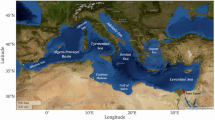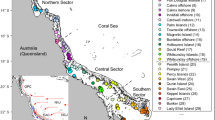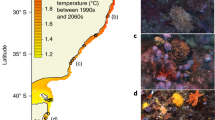Abstract
Ocean color images acquired from the Sea-viewing Wide Field-of-view Sensor (SeaWiFS) from 1998 to 2006 were used to examine the patterns of physical connectivity between land and reefs, and among reefs in the Mesoamerican Barrier Reef System (MBRS) in the northwestern Caribbean Sea. Connectivity was inferred by tracking surface water features in weekly climatologies and a time series of weekly mean chlorophyll-a concentrations derived from satellite imagery. Frequency of spatial connections between 17 pre-defined, geomorphological domains that include the major reefs in the MBRS and river deltas in Honduras and Nicaragua were recorded and tabulated as percentage of connections. The 9-year time series of 466 weekly mean images portrays clearly the seasonal patterns of connectivity, including river plumes and transitions in the aftermath of perturbations such as hurricanes. River plumes extended offshore from the Honduras coast to the Bay Islands (Utila, Cayo Cochinos, Guanaja, and Roatán) in 70% of the weekly mean images. Belizean reefs, especially those in the southern section of the barrier reef and Glovers Atoll, were also affected by riverine discharges in every one of the 9 years. Glovers Atoll was exposed to river plumes originating in Honduras 104/466 times (22%) during this period. Plumes from eastern Honduras went as far as Banco Chinchorro and Cozumel in Mexico. Chinchorro appeared to be more frequently connected to Turneffe Atoll and Honduran rivers than with Glovers and Lighthouse Atolls, despite their geographic proximity. This new satellite data analysis provides long-term, quantitative assessments of the main pathways of connectivity in the region. The percentage of connections can be used to validate predictions made using other approaches such as numerical modeling, and provides valuable information to ecosystem-based management in coral reef provinces.







Similar content being viewed by others
References
Andréfouët S, Mumby PJ, McField M, Hu C, Muller-Karger FE (2002) Revisiting coral reef connectivity. Coral Reefs 21:43–48
Andréfouët S, Muller-Karger FE, Robinson JA, Kranenburg CJ, Torres-Pulliza D, Spraggins SA, Murch B (2006) Global assessment of modern coral reef extent and diversity for regional science and management applications: a view from space. Proc 10th Int Coral Reef Symp 1:1732–1745
Beech T, Dowd M, Field C, Hatcher B, Andréfouët S (2008) A stochastic approach to marine reserve design: incorporating data uncertainty. Ecological Informatics 3 [doi:10.1016/j.ecoinf.2008.09.001]
Birkeland C (1997) Symbiosis, fisheries and economic development on coral reefs. Trends Ecol Evol 12(9):364–367
Black KP, Moran PJ, Hammond LS (1991) Numerical models show coral reefs can be self-seeding. Mar Ecol Prog Ser 74:1–11
Burke L, Sugg Z (2006) Hydrological modeling of watersheds discharging adjacent to the Mesoamerican Reef. World Resources Institute (WRI) Watershed analysis for the Mesoamerican Reef, Washington, DC
Cayula JF, Cornillon P (1992) Edge detection algorithm for SST images. J Atmos Ocean Tech 9:67–80
Chérubin LM, Kuchinke CP, Paris CB (2008) Ocean circulation and terrestrial runoff dynamics in the Mesoamerican region from SeaWiFS data and a high resolution simulation. Coral Reefs 27(3):503–519
Cowen RK, Paris CB, Srinivasan A (2006) Scaling of connectivity in marine populations. Science 311:522–527
Dayton P, Sala E, Tegner MJ, Thrush S (2000) Marine reserves, parks, baselines and fishery enhancement. Bull Mar Sci 66(3):617–634
Ezer T, Thattai DV, Kjerfve B, Heyman WD (2005) On the variability of the flow along the Meso-American Barrier Reef system: a numerical model study of the influence of the Caribbean current and eddies. Ocean Dynam 55:458–475
Fagerstrom JA (1987) The evolution of reef communities. Wiley-Interscience, New York
Gerber LR, Botsford LW, Hastings A, Possingham HP, Gaines SD, Palumbi SR, Andelman S (2003) Population models for marine reserve design: a retrospective and prospective synthesis. Ecol Appl 13(1):S47–S64
Gordon HR, Wang MH (1994) Retrieval of water-leaving radiance and aerosol optical thickness over the oceans with SeaWiFS: a preliminary algorithm. Appl Opt 33(3):443–452
Harborne AR, Afzal DC, Andrews MJ (2001) Honduras: Caribbean coast. Mar Pollut Bull 42(12):1221–1235
Hatcher BG (1997) Coral reef ecosystems: how much greater is the whole than the sum of the parts? Coral Reefs 16:77–91
Hatcher BG, Bradbury R (2006) Ocean ecosystem management: how much greater is the whole than the sum of the parts? In: Vanderzwaag D, Rothwell T (eds) Towards principled oceans governance: Australian and Canadian approaches and challenges. Routledge, Oxford, pp 205–235
Hatcher BG, Johannes RE, Robertson AI (1989) Review of research relevant to the conservation of shallow tropical marine ecosystems. Oceanogr Mar Biol Annu Rev 27:337–414
Heyman WD, Kjerfve B (1999) Hydrological and oceanographic considerations for integrated coastal zone management in Southern Belize. J Environ Manag 24:229–245
Hu C, Hackett KE, Callahan MK, Andréfouët S, Wheaton JL, Porter JW, Muller-Karger FE (2003) The 2002 ocean color anomaly in the Florida Bight: a cause of local coral reef decline? Geophys Res Lett 30(3):1151–1154
Hu C, Muller-Karger FE, Vargo GA, Neely MB, Johns E (2004) Linkages between coastal runoff and the Florida Keys ecosystem: a study of a dark plume event. Geophys Res Lett 31 [doi:10.1029/2004GL020382]
Hu C, Nelson J, Johns E, Chen Z, Weisberg B, Muller-Karger FE (2005) Mississippi River water in the Florida Straits and in the Gulf Stream off Georgia in summer 2004. Geophys Res Lett 32 [doi:10.1029/2005GL022942]
Jackson C (2007) Internal wave detection using the Moderate Resolution Imaging Spectroradiometer (MODIS). J Geophys Res 112 [doi:10.1029/2007JC004220]
Kramer PA, Kramer PR (2002) Ecoregional conservation planning for the Mesoamerican Carribbean Reef. World Wildlife Fund, Washington, DC
Largier JL (2003) Considerations in estimating larval dispersal distances from oceanographic data. Ecol Appl 13:S71–S89
McClanahan T, Muthiga N (1998) An ecological shift in a remote coral atoll of Belize over 25 years. Environ Conserv 25:122–130
Muller-Karger FE, Richarson PL, McGillicuddy D (1995) On the offshore dispersal of the Amazon’s plume in the North Atlantic: comments on the paper by A. Longhurst, “Seasonal cooling and blooming in tropical oceans”. Deep-Sea Res Part I 42:2127–2137
O’Reilly JE, Maritorema S, O'Brien MC, Siegel DA, Toole D, Mitchell BG, Kahru M, Chavez FP, Strutton P, Cota GF, Hooker SB, McClain C, Carder KL, Muller-Karger FE, Harding L, Magnuson A, Phinney D, Moore GF, Aiken J, Arrigo KR, Letelier R, Culver M (2000) Ocean color chlorophyll algorithms for SeaWiFS, OC2, and OC4: version 4. In: Hooker SB, Firestone ER (eds) SeaWiFS postlaunch technical report series. NASA Technical Memorandum, 2000–206892, vol 11
Ogden JC (1997) Marine managers look upstream for connections. Science 278:1414–1415
Palumbi SR (2004) Marine reserves and ocean neighborhoods: the spatial scale of marine populations and their management. Annu Rev Environ Resour 29:31–68
Paris CB, Chérubin LM (2008) River-reef connectivity in the Meso-American Region. Coral Reefs 27:773–781 [doi: 10.1007/s00338-008-0396-1]
Portig WH (1976) The climate of Central America. In: Schwerdtfeger W (ed) Climates of Central and South America. Elsevier, Amsterdam, pp 405–478
Roberts CM (1997) Connectivity and management of Caribbean coral reefs. Science 278:1454–1457
Rogers CS (1990) Responses of coral reefs and reef organisms to sedimentation. Mar Ecol Prog Ser 62:185–202
Sala E, Aburto-Oropeza O, Paredes G, Parra I, Barrera JC, Dayton PK (2002) A general model for designing networks of marine reserves. Science 298:1991–1993
Sale PF, Hatcher BG, Chavez E, Mayfield CL, Chiborowski J (1999) Guidelines for developing a regional monitoring and environmental information system (EIS) for the MBRS. Final Report for the World Bank project: Conservation and sustainable use of the Mesoamerican Barrier Reef System (MBRS) in Mexico, Belize, Guatemala and Honduras, United Nations University, Hamilton
Sheng J, Wang L, Andréfouët S, Hu C, Hatcher BC, Muller-Karger FE, Kjerfve B, Heyman WD, Yang B (2007) Upper ocean response of the Mesoamerican Barrier Reef System to hurricane Mitch and coastal freshwater inputs: a study using Sea-Viewing Wide Field-of-view Sensor (SeaWiFS) ocean color data and a nested-grid ocean circulation model. J Geophys Res 112 [doi: 10.1029/2006JC003900]
Stegmann PM, Ullman DS (2004) Variability in chlorophyll and sea surface temperature fronts in the Long Island Sound outflow region from satellite observations. J Geophys Res 109 [doi:10.1029/2003JC001984]
Tang L, Sheng J, Hatcher BG, Sale PF (2006) Numerical study of circulation, dispersion, and hydrodynamic connectivity of surface waters on the Belize shelf. J Geophys Res 111 [doi:10.1029/2005JC002930]
Ullman DS, Cornillon PC (1999) Satellite-derived sea surface temperature fronts on the continental shelf out off the northeast US coast. J Geophys Res 104:23,459–23,478
Wall CC, Muller-Karger FE, Roffer MA, Hu C, Yao W, Luther ME (2008) Satellite remote sensing of surface oceanic fronts in coastal waters off west-central Florida. Remote Sens Environ 112:2963–2976 [doi:10.1016/j.rse.2008.02.007]
Wilkinson CR (1999) Global and local threats to coral reef functioning and existence: review and prediction. Mar Freshw Res 50:867–878
Wolanski E, Mazda Y, Furukawa K, Ridd P, Kitheka J, Spagnol S, Stieglitz T (2000) Water circulation through mangroves and its implications for biodiversity. In: Wolanski E (ed) Oceanographic processes of coral reefs: physical and biological links in the Great Barrier Reef. CRC Press, Boca Raton, Florida, pp 53–76
Wolanski E, Richmond R, McCook L, Sweatman H (2003) Mud, marine snow and coral reefs. Am Sci 91:44–49
Acknowledgments
This work was supported by the NASA Earth Observing System’s Interdisciplinary Program (grant NNG04F090G). SeaWiFS data are property of the Orbimage Corporation and are used here in accordance with the SeaWiFS Research Data Use Terms and Conditions Agreement of the NASA SeaWiFS Project. We are also thankful to the anonymous reviewers and the various Editors whose comments helped improved this manuscript. IMaRS contribution 129.
Author information
Authors and Affiliations
Corresponding author
Additional information
Communicated by Geology Editor Dr. Bernhard Riegl
Electronic supplementary material
Below is the link to the electronic supplementary material.
Rights and permissions
About this article
Cite this article
Soto, I., Andréfouët, S., Hu, C. et al. Physical connectivity in the Mesoamerican Barrier Reef System inferred from 9 years of ocean color observations. Coral Reefs 28, 415–425 (2009). https://doi.org/10.1007/s00338-009-0465-0
Received:
Revised:
Accepted:
Published:
Issue Date:
DOI: https://doi.org/10.1007/s00338-009-0465-0




